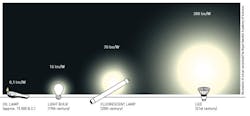Blue LED creators receive Nobel Prize in Physics for 2014
Isamu Akasaki, Hiroshi Amano, and Shuji Nakamura created the first blue LEDs in the early 1990s, paving the way for functional white light from LEDs, and will now received the Nobel Prize for Physics.
The Royal Swedish Academy of Sciences has awarded the 2014 Nobel Prize for Physics to the team of researchers that created the first blue LEDs in the early 1990s and ultimately enabled functional white light output from LED sources. Isamu Akasaki (Meijo University, Nagoya, Japan and Nagoya University, Japan), Hiroshi Amano (Nagoya University, Japan), and Shuji Nakamura (University of California, Santa Barbara, CA) have been honored "for the invention of efficient blue light-emitting diodes which has enabled bright and energy-saving white light sources."
Illustration: Johan Jarnestad/The Royal Swedish Academy of Sciences
The trio of scientists will formally receive their Nobel awards in December at a ceremony in Stockholm. The three will also share a monetary prize of SEK 8 million ($1.1 million). The Academy noted that the blue LED was crucial in creating white light by combining with existing red and green LEDs. More recently, the white light is most often generated by a blue LED along with a mix of yellow, red, and/or green phosphors in a phosphor-converted white LED.
The Academy released the infographic depicted nearby that demonstrates the impact that LED sources can have on energy consumption. Indeed, LED sources have reached 300 lm/W in efficacy in the lab. At the system level, shipping solid-state lighting (SSL) products regularly achieve efficacy in the 150 lm/W level.
"With 20% of the world’s electricity used for lighting, it’s been calculated that optimal use of LED lighting could reduce this to 4%," said Frances Saunders, president of the Institute of Physics, in response to the Nobel announcement. "Akasaki, Amano, and Nakamura’s research has made this possible and this prize recognizes this contribution."
The Academy also noted that LEDs combined with solar energy hold the promise of bringing light to 1.5 billion people globally who lack access to electricity. Indeed, as we have chronicled, LEDs are breathing new life into solar technology. A speaker at the Strategies in Light conference back in February also described the advances in LEDs and solar power.
It's also notable that the Nobel Award to the blue-LED inventors comes as we approach what the United Nations has declared the Year of Light in 2015. Saunders added, "It’s wonderful that the Nobel Foundation have chosen to commend these three physicists’ work on the cusp of the International Year of Light 2015, a global initiative to highlight the importance of light in our lives."
Nakamura in particular has been recognized a number of times previously for his work with the blue LED. He won the 2006 Millennium Technology Prize, and continues to be involved in the industry and is one of the founders of Soraa.
It's also important to recognize the work in red and other LEDs that preceded the invention of the blue LED. Back in 2012, for instance, GE celebrated the 50th birthday of visible LED lighting and the work of its researcher Nick Holonyak in creating that LED.

Maury Wright | Editor in Chief
Maury Wright is an electronics engineer turned technology journalist, who has focused specifically on the LED & Lighting industry for the past decade. Wright first wrote for LEDs Magazine as a contractor in 2010, and took over as Editor-in-Chief in 2012. He has broad experience in technology areas ranging from microprocessors to digital media to wireless networks that he gained over 30 years in the trade press. Wright has experience running global editorial operations, such as during his tenure as worldwide editorial director of EDN Magazine, and has been instrumental in launching publication websites going back to the earliest days of the Internet. Wright has won numerous industry awards, including multiple ASBPE national awards for B2B journalism excellence, and has received finalist recognition for LEDs Magazine in the FOLIO Eddie Awards. He received a BS in electrical engineering from Auburn University.





